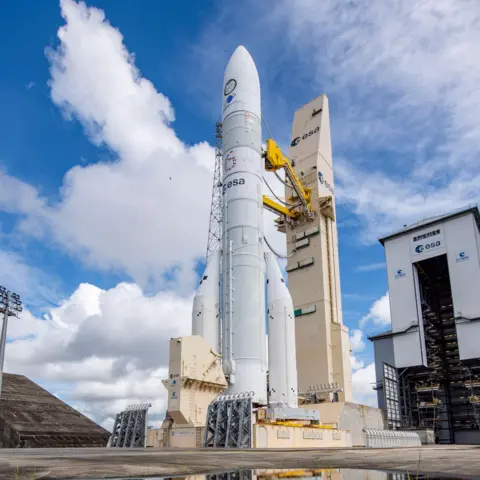 ESA/CNES/ARIANEROUP
ESA/CNES/ARIANEROUPEurope’s big new rocket, Ariane-6, is set to make its inaugural flight later.
The vehicle will launch out of French Guiana on a demonstration mission to put a clutch of satellites in orbit.
Developed at a cost of €4bn (£3.4bn), Ariane-6 is intended to be a workhorse rocket that gives European governments and companies access to space independently from the rest of the world.
It already has a backlog of launch contracts but there are worries its design could limit future prospects.
Like its predecessor, Ariane-5, the new model is expendable – a new rocket is needed for every mission, whereas the latest American vehicles are being built to be wholly or partially re-usable.
Nonetheless, European space officials believe Ariane-6 can carve out a niche for itself.
“This is a big moment,” said European Space Agency (Esa) director-general Josef Aschbacher.
“Daily life today really depends on information from satellites, from telecommunications and Earth observation to weather forecasting and disaster management. It is unimaginable for Europe not to have guaranteed, independent access to space,” he told BBC News.
Lift-off from the equatorial Kourou spaceport is scheduled to occur during a three-hour window, starting at 16:00 local time (21:00 CEST; 20:00 BST).

On the surface, the 6 looks very similar to the old 5, but under the skin it harnesses state-of-the-art manufacturing techniques (3D printing, friction stir welding, augmented reality design, etc) that should result in faster and cheaper production.
Ariane-6 will operate in two configurations:
- The “62” will incorporate two solid-fuel side boosters for lifting medium-sized payloads
- The “64” will have four strap-on boosters to lift the heaviest satellites on the market
The core stage is supplemented with a second, or upper, stage that will place the payloads in their precise orbits high above the Earth.
This stage can be stopped and re-started multiple times, which is useful when launching large batches of satellites into a constellation, or network. The re-ignition capability also enables the stage to pull itself back down to Earth so it won’t become a piece of lingering space junk.
Tuesday’s mission will use the Ariane-62 variant. The rocket will ascend to an altitude of 580km before starting to offload free-flying payloads.
These are a mix of university and commercial spacecraft. They include two capsules that will endeavour to survive a fiery fall through the atmosphere to splash down in the Pacific.
One of the capsules, which goes by the name of Nyx Bikini, is a small-scale demonstrator from a Franco-German company that aims eventually to develop spacecraft that can transport supplies and people to and from space stations in Earth orbit.
Ariane 6 vs Falcon 9
Inaugural flights are always occasions of high jeopardy. It’s not uncommon for a new rocket design to have a failure.
Ariane-5 famously blew itself apart 37 seconds after leaving the ground on its debut in 1996. The loss was put down to an error in control software.
But a revised rocket then came back to dominate the commercial launch market for the world’s biggest satellites. That dominance was only broken in the 2010s by US entrepreneur Elon Musk and his re-usable Falcon-9 rockets.
Falcon flight rates and prices undercut the competitiveness of Ariane-5.
 ESA
ESAEurope is moving towards re-usability but the necessary technologies will not be in service until the 2030s. And in the meantime, Mr Musk is introducing even bigger rockets that promise to reduce launch costs still further.
Ariane-6 enters a very challenging environment, therefore.
“We can all have our own opinions. What I can just reaffirm is that we have an order book that is full,” said Lucia Linares, who heads space transportation strategy at Esa.
“I guess the word goes here to the customers: They have said Ariane-6 is an answer to their needs.”
 ARIANEGROUP
ARIANEGROUPThere are launch contracts to take the rocket through its first three years of operations. These include 18 launches for another US billionaire, Jeff Bezos, who wants to establish a constellation of internet satellites he calls Kuiper.
European officials aim to have Ariane-6 flying roughly once a month.
If this flight rate can be achieved then the rocket should be able to establish itself, commented Pierre Lionnet from space consultancy ASD Eurospace.
“First, we need to ensure that there is sufficient demand from European customers – the European institutional ones. Then Ariane needs to win just a few commercial customers beyond Kuiper. This would give it a market,” he told BBC News.
“But it’s a matter of pricing. If Falcon-9 is systematically undercutting the price offer of Ariane-6, there will be an issue.”
Ariane-6 is a project of 13 member states of Esa, led by France (56%) and Germany (21%). The 13 partners have promised subsidy payments of up to €340m (£295m) a year to support the early phase of Ariane-6 exploitation.
The UK was a leading player right at the beginning of Europe’s launcher programme and remains an Esa member state, but its direct involvement in Ariane ended when the Ariane-4 model was retired, in 2003.
A few UK companies continue to supply components on a commercial basis, and some spacecraft built in Britain will undoubtedly continue to fly on Ariane.
 Reuters
Reuters

